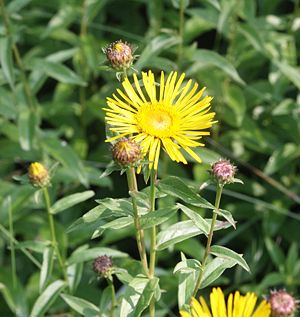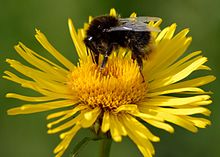Willow-leaved elephant
| Willow-leaved elephant | ||||||||||||
|---|---|---|---|---|---|---|---|---|---|---|---|---|

Willow-leaved elephant ( Pentanema salicinum ) |
||||||||||||
| Systematics | ||||||||||||
|
||||||||||||
| Scientific name | ||||||||||||
| Pentanema salicinum | ||||||||||||
| ( L. ) D.Gut.Larr., Santos-Vicente, Anderb., E.Rico & MMMart.Ort. |
The Willowleaf elecampane or willow elecampane ( Pentanema salicinum ) is a plant from the genus of Pentanema within the family of the daisy family (Asteraceae).
description



Vegetative characteristics
The willow-leaved elephant is a perennial herbaceous plant that reaches heights of 25 to 80 centimeters. It grows fast . The independently upright stem usually branches only in the upper area. The above-ground parts of the plant are more or less bare and at most on the underside of the nerves and in the lower part of the stem it is hairy with short bristles.
The grass-green, more or less at right angles protruding leaves are entire, oblong-lanceolate to oblong-ovoid and slightly curved downwards. They are bare and have weak eyelashes on the edge, underneath they have no glands. The upper stem leaves have a heart-shaped base that at least partially surrounds the stem.
Generative characteristics
The flowering period extends from June to October. The flower heads, which are 2.5 to 4 centimeters in diameter, are usually single, less often in groups of up to five at the ends of the stems. The bracts of the flower heads are short and densely ciliate and the outer bracts are curved back. The flower heads contain yellow ray and tubular flowers .
The number of chromosomes is 2n = 16.
ecology
The willow-leaved elephant is a hemicryptophyte . The willow-leaved elephant is a grass-growing semi-rosette plant. Vegetative spread through woody runners as root creep also takes place.
In terms of ecology, the flower heads are flowers . The pollination is done by bees and grave wasps .
As diasporas are achenes aufgebreitet with their pappus. The sinking speed of the "umbrella" is 0.27 m / s.
Occurrence
The willow-leaved elephant is widespread in temperate continental Europe and can also be found selectively in Asia and the northeastern USA. It is rare in the northwestern German lowlands . In the Allgäu Alps, it rises to an altitude of 1000 meters on the Rindberg near Sibratsgälle in Vorarlberg.
In Central Europe, the willow-leaved elephant can be found scattered in bog meadows or in semi-arid grass , in the fringes of sunny bushes and forests and on paths . This calcareous plant species thrives best on dry to moist soils rich in bases and humus in light locations. According to Ellenberg , it is a light plant, a base and lime pointer. It is a character species of the Association of the Pipe Grass Litter Meadows (Molinion).
Taxonomy
The first publication took place in 1753 under the name ( Basionym ) Inula salicina L. by Carl von Linné . According to Gutiérrez-Larruscain et al. In 2018, some species from the genus Inula were added to the genus Pentanema . There was a new combination to Pentanema salicinum (L.) D.Gut.Larr., Santos-Vicente, Anderb., E.Rico & MMMart.Ort. in David Gutiérrez-Larruscain, Maria Santos-Vicente, Arne A. Anderberg Enrique Rico, M. Martínez-Ortega: Phylogeny of the Inula group (Asteraceae: Inuleae): evidence from nuclear and plastid genomes and a recircumscription of Pentanema. In: Taxon , Volume 67, Issue 1, March 2018 on page 159.
Similar species and hybrids
Quite similar is the willow-leaved ox-eye ( Buphthalmum salicifolium ), which has somewhat wider ray florets and linear chaff leaves in the flower heads. It also has leaves that are narrowed towards the base and not encompassing half of the stem.
Inula salicina occasionally forms hybrids , for example:
- Inula × rigida Döll = Rough elephant ( Inula hirta ) × Inula salicina
- Inula × vrabelyiana nucleus. = Sword elephant ( Inula ensifolia ) × Inula salicina
Sources and further information
literature
- Henning Haeupler , Thomas Muer: picture atlas of the fern and flowering plants of Germany (= the fern and flowering plants of Germany. Volume 2). Published by the Federal Agency for Nature Conservation. Ulmer, Stuttgart 2000, ISBN 3-8001-3364-4 .
- Werner Rothmaler : Excursion flora for the areas of the GDR and the FRG. Volume 2: Vascular Plants. 14th edition. People and knowledge, Berlin 1988, ISBN 3-06-012539-2 .
- Erich Oberdorfer : Plant-sociological excursion flora. Verlag Eugen Ulmer, Stuttgart 1994, ISBN 3-8252-1828-7 .
- Heinz Ellenberg : Vegetation of Central Europe with the Alps from an ecological, dynamic and historical perspective. 5th, heavily changed and improved edition. Ulmer, Stuttgart 1996, ISBN 3-8001-2696-6 .
- Otto Schmeil, Jost Fitschen: The flora of Germany interactive. Quelle & Meyer-Verlag, 2004, ISBN 3-494-01368-3 .
- Ruprecht Düll , Herfried Kutzelnigg : Pocket dictionary of plants in Germany. A botanical-ecological excursion companion to the most important species. 6th, completely revised edition. Quelle & Meyer, Wiebelsheim 2005, ISBN 3-494-01397-7 .
- Ruprecht Düll, Herfried Kutzelnigg: Pocket dictionary of plants in Germany and neighboring countries. The most common Central European species in portrait. 7th, corrected and enlarged edition. Quelle & Meyer, Wiebelsheim 2011, ISBN 978-3-494-01424-1 .
Individual evidence
- ↑ a b Inula salicina L., Weidenblättriger Alant. In: FloraWeb.de.
- ↑ a b Erich Oberdorfer : Plant-sociological excursion flora for Germany and neighboring areas. 8th edition. Verlag Eugen Ulmer, Stuttgart 2001, ISBN 3-8001-3131-5 , p. 921.
- ↑ Erhard Dörr, Wolfgang Lippert : Flora of the Allgäu and its surroundings. Volume 2, IHW, Eching 2004, ISBN 3-930167-61-1 , p. 585.
- ↑ David Gutiérrez-Larruscain, Maria Santos-Vicente, Arne A. Anderberg Enrique Rico, M. Martínez-Ortega: Phylogeny of the Inula group (Asteraceae: Inuleae): evidence from nuclear and plastid genomes and a recircumscription of Pentanema. In: Taxon , Volume 67, Issue 1, March 2018, pp. 149–164. doi : 10.12705 / 671.10
- ^ A b c Gerhard Wagenitz : Family Compositae. In: Gustav Hegi : Illustrated flora of Central Europe. 2nd Edition. Volume VI, Part 3, Verlag Paul Parey, Berlin / Hamburg 1979, ISBN 3-489-84020-8 , pp. 172-187.
Web links
- Inula salicina subsp. salicina L., willow-leaved elephant (subspecies). In: FloraWeb.de.
- Willow-leaved elephant . In: BiolFlor, the database of biological-ecological characteristics of the flora of Germany.
- Profile and distribution map for Bavaria . In: Botanical Information Hub of Bavaria .
- Distribution map - Global biodiversity information facility . (first click on "accept terms")
- Inula salicina L. In: Info Flora , the national data and information center for Swiss flora . Retrieved April 21, 2016.
- Map for worldwide distribution at linnaeus.nrm.se.
- Thomas Meyer: Alant data sheet with identification key and photos at Flora-de: Flora von Deutschland (old name of the website: Flowers in Swabia ).
- Data sheet with photos from Botanik im Bild / Flora von Österreich , 2007.

